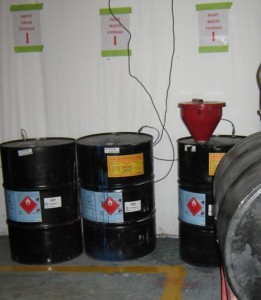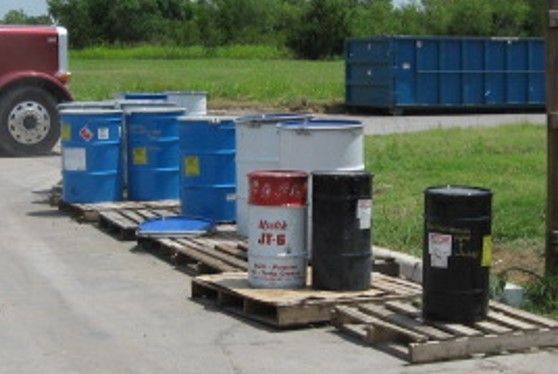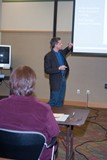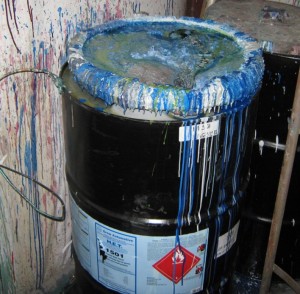A summary of the state regulations of Oklahoma pertaining to the management of hazardous waste, universal waste, used oil, and non-hazardous waste.
Disclaimer:
This information is provided as guidance only. Do not use to determine compliance with either State or Federal Regulations.
State Environmental Agency:
The Oklahoma Department of Environmental Quality (ODEQ) is authorized by the USEPA to manage the regulations of the Resource Conservation and Recovery Act (RCRA) in Oklahoma.
Logo for the Oklahoma Department of Environmental Quality
The Regulations:
State regulations for the management of hazardous waste are found in Title 252, Chapter 205 of the Oklahoma Administrative Code.

Oklahoma has adopted the Federal Rules for the definition of hazardous waste generator status:
- Generate ≥1,000 kg/mo hazardous waste or >1 kg/mo acute hazardous waste or >100 kg/mo acute hazardous waste spill residue or soil = Large Quantity Generator of hazardous waste (LQG).
- Generate >100 but <1,000 kg/mo hazardous waste = Small Quantity Generator of hazardous waste (SQG).
- Generate ≤100 kg/mo hazardous waste and ≤1 kg/mo acute hazardous waste and ≤100 kg/mo acute hazardous waste spill residue or soil = Conditionally Exempt Small Quantity Generator of hazardous waste (CESQG).
|
Not sure of your hazardous waste generator status? |
Facility Identification Number:
A Large Quantity Generator of hazardous waste and a Small Quantity Generator of hazardous waste in Oklahoma must have a twelve-digit USEPA identification number assigned by the ODEQ. CESQGs that voluntarily obtain an EPA ID Number will enter the ODEQ’s inspectable universe.
Facilities with an EPA ID Number must pay an annual monitoring fee. The monitoring fee covers the year in which the invoice is issued. For example, the 2015 invoices were mailed in late December, 2014 with their delivery anticipated in early 2015.
Oklahoma does not have state identification numbers for hazardous waste generators.
Universal Waste:
ODEQ has adopted the Federal Rule for the identification and management of universal waste.
- Four (4) potential hazardous wastes may be managed as universal waste:
- Lamps
- Batteries
- Mercury-containing devices
- Recalled or cancelled pesticides
- Four (4) types of universal waste facilities:
- Small Quantity Universal Waste Handler
- Large Quantity Universal Waste Handler
- Universal Waste Destination Facility
- Universal Waste Transporter
- Universal waste may be accumulated on-site for no more than one year. However, universal waste may be accumulated on-site for longer than one year if the universal waste handler can document the need for additional storage time, e.g. single container of universal waste is not yet full.
- Universal Waste Handler must provide training for employees applicable to handler status.
- Small Quantity Handler must “inform” employees who work with or around universal waste how to manage it in compliance with the regulations and how to respond to a universal waste spill, leak, or emergency.
- Large Quantity Handler must “ensure” all employees who work with or around universal waste are “thoroughly familiar” with how to manage it in compliance with the regulations and how to respond to a universal waste spill, leak, or emergency.
- Deliberate crushing of universal waste lamps precludes their management as universal waste and requires their management as a hazardous waste.
|
Like this article? Subscribe to my Monthly Newsletter No marketing emails! |
Used Oil:
ODEQ has adopted the Federal Rule for the identification and management of used oil.
- Definition of used oil:
- Petroleum-based or synthetic.
- Used and contaminated by that use.
- Destined for fuel-blending or recycling.
- Cannot be contaminated with a listed hazardous waste. Be especially cautious with any potential exposure to chlorinated solvents.
- Management of used oil:
- No on-site accumulation time limit.
- May be accumulated in tanks or containers.
- Tanks or containers must be labeled “Used Oil”.
- Spills and leaks cleaned up immediately.
- Cannot use for dust suppression.
- May self-transport ≤55 gallons at a time in company owned vehicles to a registered collection site or another location owned by the generator.
- Transporters of used oil (other than excluded self-transport described above) must have a USEPA Identification Number.
- Used oil filters should be hot-drained to where they are completely free of liquids. They then may be recycled as scrap metal. Federal exclusion from regulation for non-terne plated used oil filters.
Training of Facility Personnel:
Oklahoma has adopted the Federal rule for an employer’s responsibility to provide training for all Hazardous Waste Personnel (aka: Facility Personnel).
- LQG RCRA Training – Initial training (w/i 6 months) and annual review. See below for a more thorough description of the RCRA Training requirements for Facility Personnel of an LQG.
- SQG RCRA Training – Ensure all employees are “thoroughly familiar” with how to handle hazardous waste and how to respond to a hazardous waste emergency.
- The ODEQ has a more strict interpretation of the Federal regulations when it comes to Hazardous Waste Personnel Training at an SQG. The text below is from an ODEQ Power Point slide from the Hazardous Waste Small Quantity Generator Seminar:
SQGs are required to perform training for all employees who are involved with hazardous waste. Involvement includes:
- Handling of the waste (from generation point to the container).
- Management of the waste (managing the container).
- Manifesting the waste (the person who signs the manifest and the person who maintains the manifest).
- Emergency or Contingency Plan (all employees should know the Emergency Coordinator and what to do in emergency events)
- CESQG RCRA Training – No training requirement, but still a good idea. RCRA regulations applicable to a CESQG.
Handlers of universal waste have responsibility for some form of training as well. Refer to the Universal Waste portion of this document.
Training requirements for the Facility Personnel of a Large Quantity Generator of hazardous waste:
- All Facility Personnel must be trained on the management of hazardous waste in a way that teaches them how to do their job in compliance with State and Federal regulations.
- Training program may be classroom instruction or on-the-job training or a combination of the two.
- Employer must ensure that the training program includes all the elements the training records indicate were addressed during training. In other words: “Say what you do. Do what you say!”
- Training program must be directed by a person trained in hazardous waste management procedures.
- Training program must include instruction which teaches Facility Personnel what they need to know in order to perform their job duties in compliance with State and Federal hazardous waste regulations. This includes responding to a hazardous waste emergency as described in the facility’s RCRA Contingency Plan.
- At a minimum, the training program must ensure that Facility Personnel are able to respond effectively to emergencies.
- Training must familiarize Facility Personnel with emergency procedures, emergency equipment, and emergency systems including where applicable:
- Procedures for using, inspecting, repairing, and replacing emergency and monitoring equipment.
- Key parameters for automatic waste feed cut-off systems.
- Communications or alarm systems.
- Response to fires or explosions.
- Shutdown of operations.
- Facility Personnel must successfully complete the program required within six months after the date of their employment or assignment or to a new position.
- Untrained Facility Personnel must be directly supervised by trained and knowledgeable Facility Personnel until they receive training.
- Facility Personnel must take part in an annual review of the initial training.
|
Training Services I provide for HazMat Employees & Hazardous Waste Personnel: |
Hazardous Waste Emergency Preparedness and Prevention:
ODEQ has adopted the USEPA regulations at 40 CFR 265, Subpart C Preparedness and Prevention, including:
- The requirements of Subpart C apply to Large Quantity Generators and Small Quantity Generators of hazardous waste. They do not apply to a CESQG.
- Facility must be maintained and operated in a manner to minimize the possibility of a fire, explosion, or unplanned release of hazardous waste or hazardous waste constituent.
- Facility must provide the following equipment:
- Internal emergency communication system or alarm.
- A device capable of summoning emergency assistance from external agencies.
- Fire suppression equipment.
- Spill control equipment.
- Decontamination equipment.
- Water at adequate volume to supply fire suppression system.
- All equipment must be tested and maintained as necessary.
- Facility must ensure immediate access to emergency communication or alarm systems.
- Facility must provide adequate aisle space to allow for unobstructed movement of personnel and equipment to any area of the facility in an emergency.
- Facility must designate its primary external emergency response agencies.
- Facility must attempt to familiarize external emergency response agencies with the layout of its facility, the potential hazards, and other emergency response information.
Contingency Plan and Emergency Procedures:
ODEQ follows the Federal rule at 40 CFR 265, Subpart D Contingency Plan and Emergency Procedures, including:
- The requirements of Subpart D apply to a Large Quantity Generator of hazardous waste, but not to a Small Quantity Generator or a CESQG.
- Facility must have a documented contingency plan designed to minimize hazards to human health and the environment from a fire, explosion, or unplanned release of a hazardous waste.
- Contingency Plan to include:
- Description of actions facility personnel will take in the event of an emergency.
- Arrangements to respond in an emergency agreed to by state and local emergency response agencies.
- Name and address – office and home – of emergency coordinators.
- List of all emergency equipment at the facility including its location, a physical description, and its capabilities.
- Facility evacuation plan.
- Contingency plan may be combined with other emergency response plans at the facility such as the Spill Prevention Control and Countermeasure (SPCC) Plan required for certain facilities by the Clean Water Act, and many others. This combined plan is known as the Integrated Contingency Plan or “One Plan”.
- A copy of the contingency plan must be maintained at the facility and copies provided to local emergency response agencies.
- Contingency plan must be reviewed and immediately amended if the facility changes, the regulations changes, or the plan fails in an emergency.
- At least one facility employee must function as the emergency coordinator.
- Responsibilities of the emergency coordinator:
- Activate internal alarms or communication system.
- Notify state or local agencies as necessary.
- Identify the nature of any emergency.
- Assess possible hazards to human health or the environment.
- Make external notifications to local, state, and Federal agencies depending on the nature of the emergency.
- Ensure the emergency does not spread or recur.
- Monitor operations that may shut-down during the emergency to ensure there are no leaks, pressure build-ups, etc.
- After the emergency, provide for disposal of any waste.
- Ensure no incompatible material enters the contaminated area.
- Ensure all emergency response equipment is restored to a useable condition.
- Note in the operating record relevant information about the incident.
- Submit a written report about the incident to the ODEQ within 15 days.
Reporting of Spills, Releases and Emergencies:
ODEQ spill reporting hotline is (800) 522-0206
Uniform Hazardous Waste Manifest:
USEPA requires the use of the Uniform Hazardous Waste Manifest for both large quantity generators and small quantity generators of hazardous waste – but not CESQGs – without regard for state regulations. It is the responsibility of the generator of the waste to ensure the manifest is obtained from a registered printer.
- A Large Quantity Generator of hazardous waste must contact the initial transporter or the Designated Facility identified on the Uniform Hazardous Waste Manifest if he has not received a copy of the manifest signed by the Designated Facility within 35 days of the date the manifest was accepted – and signed – by the initial transporter.
- An LQG must submit an Exception Report to the ODEQ if he has not received a copy of the manifest signed by the Designated Facility within 45 days of the date the manifest was accepted – and signed – by the initial transporter.
- A Small Quantity Generator of hazardous waste must submit a legible copy of the manifest with some indication he has not received confirmation of delivery to the ODEQ if he has not received a copy of the manifest signed by the Designated Facility within 45 days of the date the manifest was accepted – and signed – by the initial transporter.
The Waste Minimization Statement:
- Reference is made to the Waste Minimization Statement (40 CFR 262.27) in the Generator’s/Offeror’s Certification in Section 15 of the Uniform Hazardous Waste Manifest. It reads: “I certify that the waste minimization statement identified in 40 CFR 262.27(a) (If I am a large quantity generator) or (b) (if I am a small quantity generator) is true.”
- The Waste Minimization Statement for a Large Quantity Generator of hazardous waste reads: “I am a large quantity generator. I have a program in place to reduce the volume and toxicity of waste generated to the degree I have determined to be economically practicable and I have selected the practicable method of treatment, storage, or disposal currently available to me which minimizes the present and future threat to human health and the environment;”
- The Waste Minimization Statement for a Small Quantity Generator of hazardous waste reads: “I am a small quantity generator. I have made a good faith effort to minimize my waste generation and select the best waste management method that is available to me and that I can afford.”
Oklahoma does not have any state-specific requirements related to the management of the Uniform Hazardous Waste Manifest:
- No state-specific waste codes.
- Oklahoma does not require copies of manifests be submitted to the ODEQ regardless of whether the waste originates or is disposed of in the state. The only exceptions are when the shipment is an international shipment or the ODEQ is the generator of the waste. Mailing address for ODEQ:
Oklahoma Department of Environmental Quality
Land Protection Division
PO Box 1677
Oklahoma City, OK 73101-1677
- ODEQ no longer requires the disposal plan number on manifests. The regulations were amended to remove this requirement in conformance with the federal uniform hazardous waste manifest regulations.
Reporting:
Facilities are required to submit an Initial Notification of Regulated Waste Activity Form (Federal Form 8700-12) prior to beginning any of the following activities:
- Large Quantity Generator or Small Quantity Generator of hazardous waste.
- Hazardous waste transporter or transfer facility.
- Hazardous Waste Treatment, Storage, or Disposal Facility.
- Large Quantity Handler or Destination Facility for universal waste.
- Hazardous waste recycler.
- Transport, process, or re-refine used oil; burn off-spec used oil for energy recovery; or market used oil.
- Eligible academic entity opting into 40 CFR 262, Subpart K.
- Managing a hazardous secondary material.
Facilities are required to submit a Subsequent Notification of Regulated Waste Activity Form (Federal Form 8700-12) for any of the following activities:
- Change to site contact or ownership.
- Change to type of RCRA Subtitle C activity conducted.
- An eligible academic entity opting into or out of regs for managing lab hazardous wastes at 40 CFR 262, Subpart K.
- Change to management of hazardous secondary material.
Provisional numbers (for emergency situations and one-time events) that are good for one year can be obtained by contacting OK DEQ at (405) 702-5100. These numbers can be assigned at the time of the telephone call. Information needed to assign the provisional number is the name of the generator and location where the waste is generated. The location must have a street address or distance from a highway intersection in addition to the city and county. If the location is in a rural area, use the name of the nearest town.
Large Quantity Generators of hazardous waste (not SQGs or CESQGs) must submit the Biennial Hazardous Waste Report by March 1st of every even-numbered year for the previous calendar year.
Oklahoma large quantity generators are required to submit a quarterly report summarizing wastes generated in a given calendar quarter (OAC 252:205-5-3). Treatment Storage and Disposal Facilities are required to submit a monthly report summarizing wastes treated, stored or disposed of each month (OAC 252:205-9-2). To correct errors on reports already submitted to DEQ, an LQG or TSDF must make a copy of the report submitted, mark it revised, add the corrections and mark the corrections as revised.
Oklahoma has no reporting requirements for small quantity generators nor conditionally exempt small quantity generators unless they become large quantity generators.
ODEQ requires a Disposal Plan for in-state large quantity generators and out-of-state LQGs that dispose of their hazardous waste in Oklahoma TSDFs. This includes SQGs, CESQGs, and non-generators of waste if they generate above LQG threshold quantity hazardous waste due to a spill or cleanup of historical waste. Only wastes defined as hazardous wastes by federal regulations (40 CFR 260-277) need to be included on a Disposal Plan. Nonhazardous waste identified on a Disposal Plan must comply with all hazardous waste regulations.
To obtain a Disposal Plan, facilities must submit an application with the required information (see below) and pay a fee. Approval by the ODEQ is typically less than five days. Emergency approvals can be obtained in as little as a few hours. One Time Disposal Plans expire automatically after one year from the date the plan originated. Continuous disposal plans must renewed annually. Invoices are mailed the month before the anniversary date
Required information on the Disposal Plan application:
- EPA ID Number.
- Basic facility information: company name, mailing and site address, contact person information.
- Detailed waste description: waste common name, USEPA waste code, estimated amount of waste produced (not binding), Physical characteristics (solid, liquid, etc.), chemical characteristics (flash point, pH, etc.). A USDOT Shipping Description is usually too vague to accurately describe a particular waste stream and should not be used for required waste common name.
- Process generating waste, e.g.: soil remediation, paint boot operations, TSDF consolidation, etc.
- Treatment Storage and Disposal Facility information: EPA ID Number , name and address.
- Signature of plant contact. The Disposal Plan may not be signed a broker or consultant of the facility.
Recordkeeping:
ODEQ has adopted the Federal rule for recordkeeping of documents demonstrating compliance with the RCRA regulations. Read the Federal Rule for maintaining records of RCRA documents. In general, an LQG or SQG must maintain copies of documents as a record for three years from its effective date.
On-Site Management of Hazardous Waste in Containers:
- Containers in good condition
- Containers compatible with contents.
- Containers kept closed except when adding or removing hazardous waste.
- Hazardous waste or hazardous waste residue must not be present on the outside of the container.
- Containers must be labeled:
- “Hazardous Waste”
- Date of initial accumulation (unless managed in a Satellite Accumulation Area pursuant to 40 CFR 262.34(c)).
|
Contact me with any questions you may have about the transportation of hazardous materials or the management of hazardous waste Daniels Training Services 815.821.1550 |
Satellite Accumulation of Hazardous Waste:
ODEQ has adopted the Federal Rule at 40 CFR 262.34(c):
- Limited to containers only, no tanks.
- Container must be at or near point of generation of hazardous waste.
- Container must be under the control of the operator of the process generating the hazardous waste.
- No more than 55 gallons of hazardous waste or 1 quart of acute hazardous waste in a single satellite accumulation area.
- No limit on number of satellite accumulation areas in a facility or the aggregate volume of hazardous waste maintained in satellite accumulation areas.
- Container must be labeled with the words “Hazardous Waste” or some other description of the container contents, eg. “Paint Waste”.
- May have more than one container in a single satellite accumulation area.
- May have more than one type of hazardous waste in a single satellite accumulation area.
- When 55 gallon or 1 quart volume threshold is reached, hazardous waste container must be immediately dated. Generator is allowed three calendar days to move the hazardous waste container from the satellite accumulation area to the central accumulation area (aka: 90/180 day accumulation area). Once moved to the central accumulation area, the generator may re-date the container and accumulate it on-site for the number of days appropriate for their hazardous waste generator status.
- Container in satellite accumulation area must be kept closed except when adding or removing hazardous waste. Container must be maintained in good condition.
- Containers in satellite accumulation areas are not subject to the following:
- Training requirements for facility personnel, though training is still highly recommended.
- Weekly container inspections, though recommended.
- RCRA air emission standards of 40 CFR 265, Subpart CC.
- Hazardous waste managed correctly in a satellite accumulation area is not subject to on-site accumulation time limits.
- Hazardous waste managed in a satellite accumulation area continues to be counted towards a generators hazardous waste generator status.
Management of Hazardous Waste by a Conditionally Exempt Small Quantity Generator (CESQG)
ODEQ has adopted the Federal Rule at 40 CFR 261.5. In order to maintain its status as a Conditionally Exempt Small Quantity Generator of hazardous waste a CESQG must comply with the following:
- Complete the hazardous waste determination for all waste generated. While maintaining a record of the hazardous waste determination is not required, it is recommended.
- Do not accumulate ≥1,000 kg of hazardous waste on-site at one time. If so, the CESQG becomes subject to all of the requirements of a Small Quantity Generator (SQG).
- Treat or dispose of hazardous waste on-site or ensure delivery to an off-site treatment, storage or disposal facility. Whether on-site or off, the TSDF must be one of the following:
- Permitted by the USEPA to manage hazardous waste.
- Authorized by a state to manage hazardous waste if that state has an authorized hazardous waste program under RCRA. This state authorization does not require a permit. It could include a household hazardous waste collection site that is authorized by ODEQ.
- Permitted by a state to manage municipal solid waste.
- Permitted by a state to manage non-municipal non-hazardous waste.
- Beneficially uses or reuses, or legitimately recycles or reclaims its waste; or treats its waste prior to beneficial use or reuse, or legitimate recycling or reclamation.
- For universal waste, a universal waste handler or destination facility subject to the requirements of part 273 of this chapter.
Management of Solvent-Contaminated Wipes:
A conditional exclusion for solvent-contaminated wipes from both Solid Waste & Hazardous Waste became effective in the Federal regulations of the USEPA on January 31, 2014. States with authorized hazardous waste programs have the option to adopt the regulation as is or with its own modifications or to reject the conditional exclusion entirely (Status of Solvent Wipe Conditional Exclusion in Your State).
Based on a telephone conversation with Roarke Blackwell of the ODEQ on November 18, 2015, the ODEQ has adopted the Federal Rule for the solvent-contaminated wipe exclusion.
Use of State-Certified Labs for Hazardous Waste Determination:
Pursuant to a telephone conversation with Roarke Blackwell of the ODEQ, the agency does not require the use of a state-certified or approved lab for the analysis of samples for the hazardous waste determination.
Non-Hazardous Waste:
In Oklahoma, a non-hazardous industrial waste must be managed on-site in a manner that does not cause harm to the environment or create a nuisance. In addition, non-hazardous industrial waste must be disposed of in a state-approve or RCRA permitted facility.
More information about non-hazardous industrial waste in Oklahoma can be found on the ODEQ Solid Waste Main Page.
Do you have a question about some aspect of the Oklahoma hazardous waste regulations that you don’t see here? Please ask me. I’m glad to help.
|
Daniels Training Services 815.821.1550 |
Sources of additional information:
- OK DEQ Hazardous Waste FAQs: http://www.deq.state.ok.us/lpdnew/hw/hazwaste.html
- OK DEQ Hazardous Waste Plan Information: http://www.deq.state.ok.us/lpdnew/hw/dpfaq.html
- OK DEQ Small Quantity Generator FAQs:




